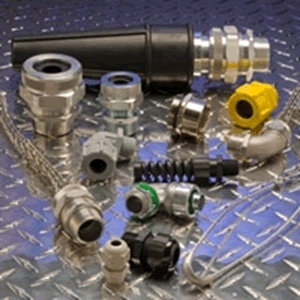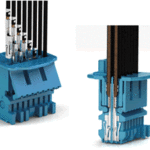Problem Solved: Flex Connectors Increase Up Time at Ford Plant
After experiencing numerous costly downtimes, Ford turned to Remke for an alternative to the hard-wired cable that connected its welding robots.

Remke’s Tuff Flex family
Sudden downtime of an automotive assembly line can be costly. Industry experts estimate that downtime can cost a manufacturer as much as $1 million per hour in lost revenue. Ford Motor Co. often experienced sudden downtime at its Oakville, Canada, plant when the 1,000-amp power cable hard-wired to welding robots shorted out. This occurred whenever the cable’s electrical connector broke, causing sparks to pierce the power cable. The connector broke due to wear and tear from the robot arm’s constant extreme rotation.
The assembly line often was down as long as 24 hours. Before the line could be restarted, each robot had to be disassembled and the entire power connection replaced. The power connection consists of an aluminum cord connector, stainless steel wire mesh grip, and the power cable.
After several downtimes, Ford met with Progressive Tool & Industries Co. and Remke Industries to solve the problem. Progressive Tool designed the assembly line and is responsible for its performance. Remke makes the cord connector and strain-relief mesh grip. The parties agreed that a custom electrical connector with more pullout protection was needed. The connector would need to provide better flexibility and durability, while protecting the cable from welding sparks.
Remke designed, tested, and modified several prototype connectors over a two-month period. Using a 10-ton hydraulic press to replicate strain from the robots, Remke placed the final prototype connector in a fixture and applied downward pressure on the tapered end to ensure the mechanical bond in the metal sleeve would not come apart. The connector’s breaking strength was also tested to failure to ensure maximum durability.
Once the prototype was approved, Remke developed the tooling for a two-part molding press. Part one created the tapered cone in a rubber press, while part two molded the rubber cone to a metal sleeve that housed the threaded opening. This overmold provided greater protection from cable pullout and abrasion in the harsh welding environment.
The initial custom connector Remke designed was the Tuff Flex. It featured a molded, tapered rubber cone that resisted hard knocks, splitting, and cracking. This connector not only improved the cable’s stability but also matched its arc-of-bend specifications to eliminate damage from constant, extreme rotation of the robot’s arm.
However, the Tuff Flex connector proved to be a short-term fix, as minor problems persisted. The power pulsing through the cable caused it to occasionally pulsate on the robots. So Remke engineers went back to work and created the Swivel Flex connector.
Swivel Flex incorporates some axial movement in the connector itself to prevent wear and tear during repetitive movement of the cable. It also has a clamping face for a more secure connection. Shortly after the development of the Swivel Flex connector, Ford replaced its termination system with a plug-in system. Ford now uses the pluggable, quick-disconnect system on new assembly lines. Swivel Flex connectors are used as replacements.






